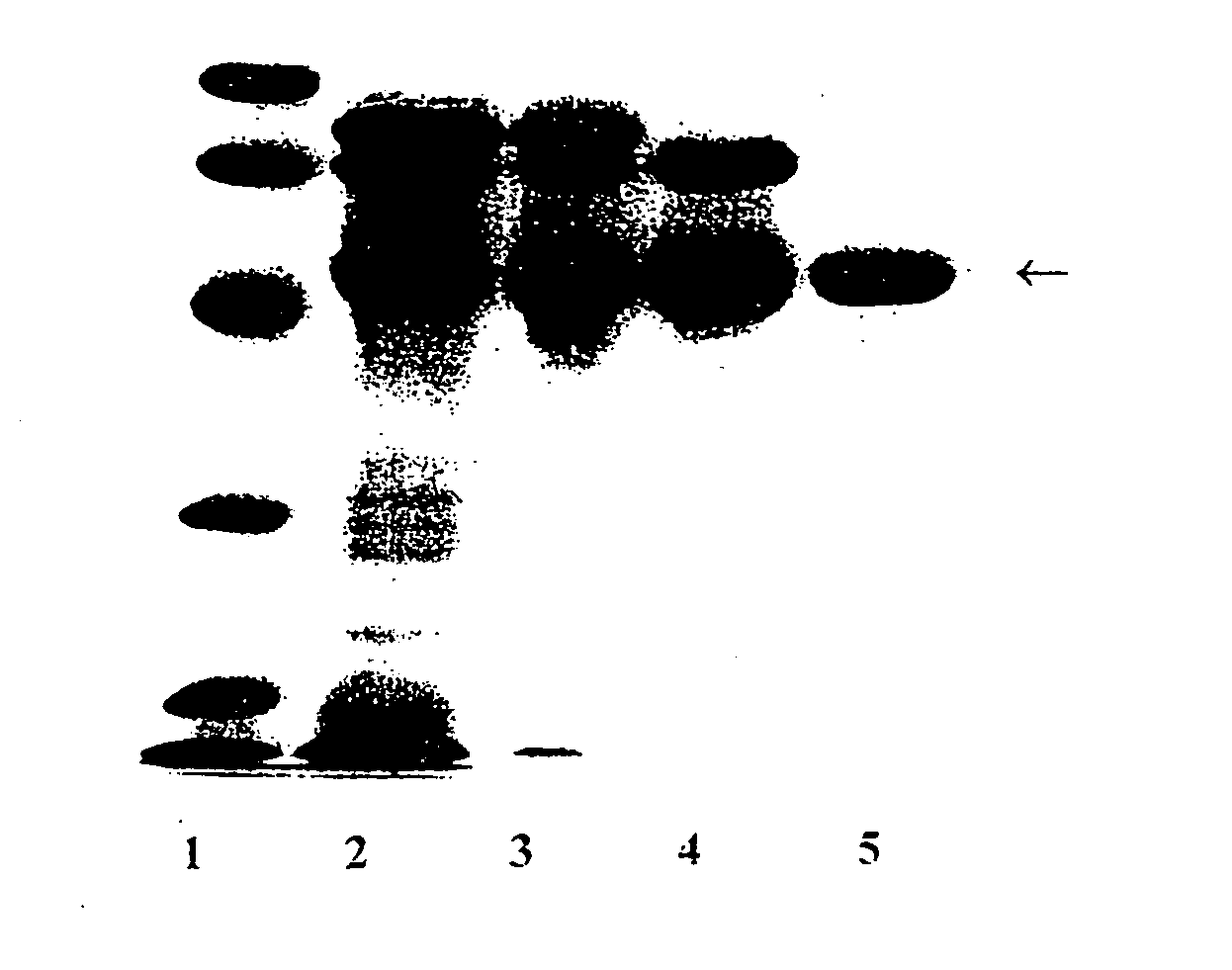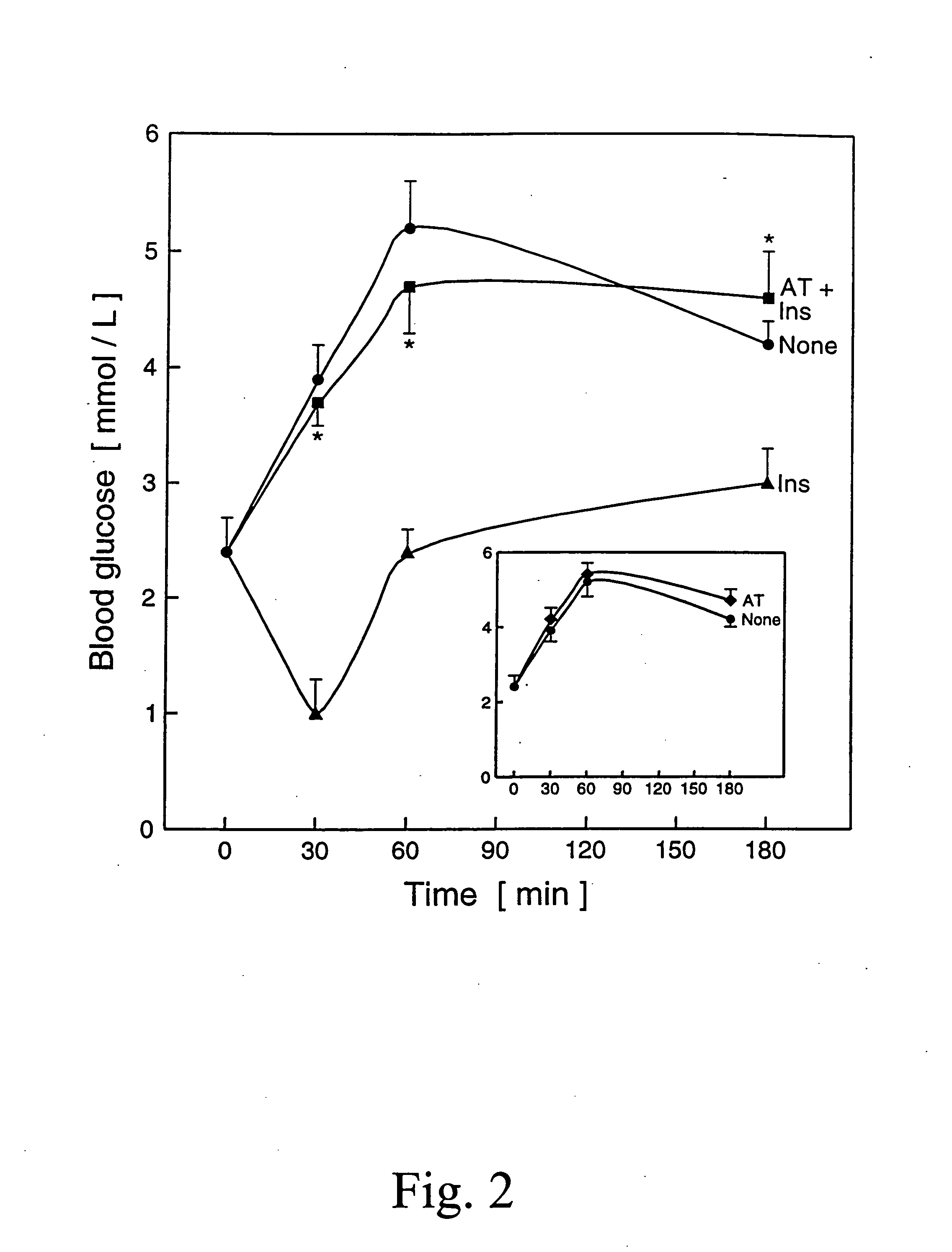Method For Improving Insulin Sensitivity By Administering an Inhibitor of Antitrypsin
a technology of antitrypsin and insulin sensitivity, which is applied in the direction of drug compositions, peptide/protein ingredients, metabolic disorders, etc., can solve the problems of reducing affecting so as to enhance or restore the sensitivity of mammals to the metabolic action, enhance or restore the sensitivity of diabetic humans, and enhance or restore the sensitivity of mammals to the metaboli
- Summary
- Abstract
- Description
- Claims
- Application Information
AI Technical Summary
Benefits of technology
Problems solved by technology
Method used
Image
Examples
example 1
Purification of AT
[0060]A partially purified human placental alkaline phosphatase preparation (PALP) was acquired from Sigma-Aldrich, Inc. AT is the major contaminant of the commercially obtained PALP. The PALP was first purified by successive concanavalin A-Sepharose and Q-Sepharose chromatography as described Chang et al. [Chang, T.-C., Huang, S.-M., Huang, T.-M. and Chang, G.-G., “Human placenta alkaline phosphatase: An improved purification procedure and kinetic studies.”Eur. J. Biochem. 209, 241-247 (1992)]. The Q-Sepharose fraction, which still contained placental alkaline phosphatase in addition to AT, was further purified to homogeneity by t-butyl HIC chromatography [Chang, T.-C., Huang, S.-M., Huang, T.-M. and Chang, G.-G., “Human placenta alkaline phosphatase: An improved purification procedure and kinetic studies.”Eur. J. Biochem. 209, 241-247 (1992)]. The 5 ml bed volume t-butyl HIC cartridge was connected to a Pharmacia FPLC system and the fractions containing AT were p...
example 2
Effect of Insulin and Commercial AT on Blood Glucose Levels in C57 / Black Female Mice in Glucose Tolerance Tests
[0062]C57 / Black female mice weighing 22-23 g were fasted for 16 hours. Four animals were used for each of four treatment groups. The first and fourth treatment group received intraperitoneal injections of 1500 μg commercially obtained AT. Exactly 23 hours and 45 minutes after the AT was administered to the first and fourth treatment group, the animals in the first and second treatment group received 0.5 I.U. of insulin. Exactly 15 minutes after the insulin was administered (i.e., 24 hours after the AT was administered to the first treatment group), glucose (3 g / kg) was injected intraperitoneally into the first, second and third treatment groups. Blood samples were taken from the eyes (canthus), and glucose concentrations in whole blood samples were immediately measured with the fast Glucose C test (Wako Chemicals USA Inc., Richmond, Va., USA). The data presented are the mea...
example 3
Effect of Insulin and Purified AT on Blood Glucose Levels in C57 / Black Female Mice in Glucose Tolerance Tests
[0064]C57 / Black female mice weighing 23-25 g were fasted for 16 hours. Five animals were used for each of the three treatment groups. The first treatment group received intraperitoneal injections of 1200 μg purified AT, i.e. AT purified by the procedure of Example 1. Exactly 23 hours and 45 minutes after the AT was administered to the first treatment group, the animals in the first and second treatment group received 0.5 I.U. of insulin. Exactly 15 minutes after the insulin was administered (i.e., 24 hours after AT was administered to the first treatment group), glucose (3 g / kg) was injected intraperitoneally into the first, second and third treatment group. Blood samples were immediately measured with the fast Glucose C test (Wako Chemicals Inc. Richmond, Va., USA).
[0065]Data are given in Table 1 below. The data presented are the mean ±S.D. of five determinations, one with e...
PUM
| Property | Measurement | Unit |
|---|---|---|
| Mass | aaaaa | aaaaa |
| Molar density | aaaaa | aaaaa |
| Molar density | aaaaa | aaaaa |
Abstract
Description
Claims
Application Information
 Login to View More
Login to View More - R&D
- Intellectual Property
- Life Sciences
- Materials
- Tech Scout
- Unparalleled Data Quality
- Higher Quality Content
- 60% Fewer Hallucinations
Browse by: Latest US Patents, China's latest patents, Technical Efficacy Thesaurus, Application Domain, Technology Topic, Popular Technical Reports.
© 2025 PatSnap. All rights reserved.Legal|Privacy policy|Modern Slavery Act Transparency Statement|Sitemap|About US| Contact US: help@patsnap.com



